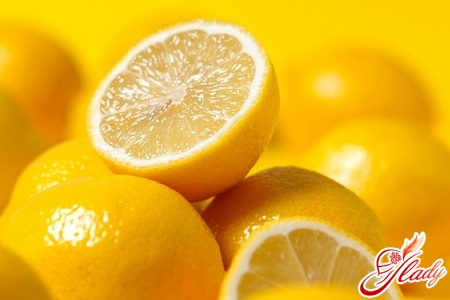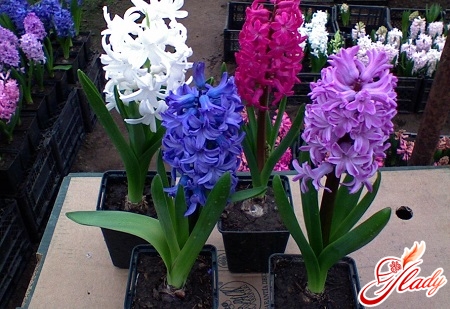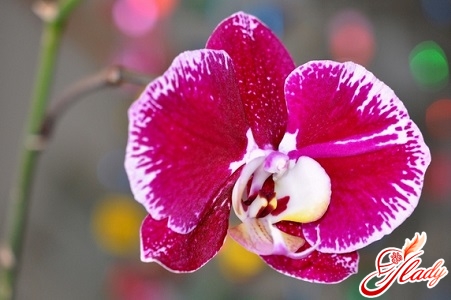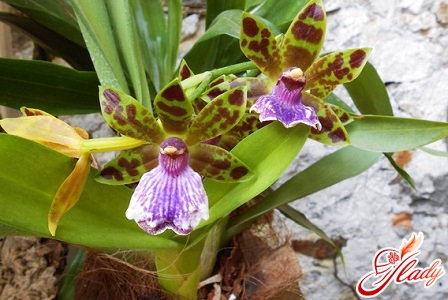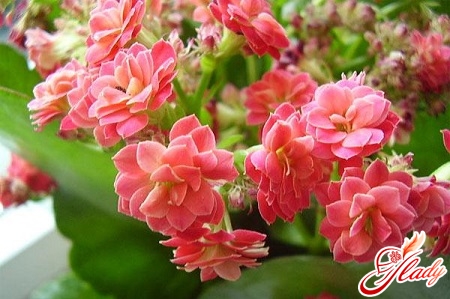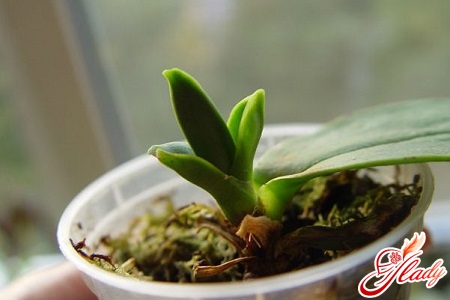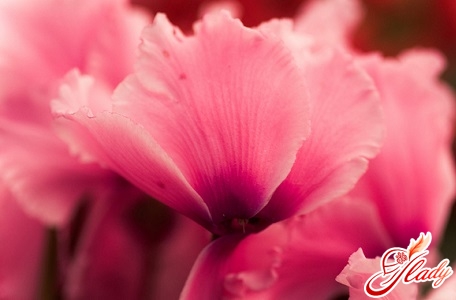 Cyclamen - indoor plant that conquersflower growers with their gentle sunny flowers. The petals of flowers are rich in their color palette: white, pink, dark red, burgundy, purple and other possible variations. And the whole value and beauty of this flower is that the period of flowering falls on the most mean time of the year - for the winter. Yes, yes, it is when basically all the plants have already dropped their flowers, and so little sun is outside the window, the cyclamen pleases and inspires us with her blossoming view. This perennial plant received its name from the Greek word "cyclos", in the meaning "circle". This shape has the main vital organ of the flower - the bulb. The most common among the indoor cyclamen species are "European", also known as "alpine violet", and "Persian". Many amateurs are afraid to start a cyclamen, arguing for their solution with a complex content and frequent plant diseases. Why is that? Care of the flower is not particularly difficult, if you know the basic rules for the favorable content of cyclamen. And the flower does not get sick more often than other plants. But yes, unfortunately, mistakes in improper care have a detrimental effect on the state of the flower: the leaves dry, the roots rot, and as a consequence - the cyclamen do not bloom.
Cyclamen - indoor plant that conquersflower growers with their gentle sunny flowers. The petals of flowers are rich in their color palette: white, pink, dark red, burgundy, purple and other possible variations. And the whole value and beauty of this flower is that the period of flowering falls on the most mean time of the year - for the winter. Yes, yes, it is when basically all the plants have already dropped their flowers, and so little sun is outside the window, the cyclamen pleases and inspires us with her blossoming view. This perennial plant received its name from the Greek word "cyclos", in the meaning "circle". This shape has the main vital organ of the flower - the bulb. The most common among the indoor cyclamen species are "European", also known as "alpine violet", and "Persian". Many amateurs are afraid to start a cyclamen, arguing for their solution with a complex content and frequent plant diseases. Why is that? Care of the flower is not particularly difficult, if you know the basic rules for the favorable content of cyclamen. And the flower does not get sick more often than other plants. But yes, unfortunately, mistakes in improper care have a detrimental effect on the state of the flower: the leaves dry, the roots rot, and as a consequence - the cyclamen do not bloom.
Rules of maintenance for a favorable flowering
In the garden shops cyclamen is mainly soldautumn, when the buds were already formed and began to blossom. Therefore, when choosing a flower, pay attention to the plant, which is already ready to bloom or has still quite unrevealed buds. Naturally, the selected flower should not have any external damage, the leaves should be juicy low-lying. The main criterion for further successful flowering is the planting of the cyclamen tuber. In no case should it be immersed in the ground completely, no less than 1/3 of the part should be visible on the surface. Cyclamens are very fond of diffuse light and react painfully to direct sunlight. If you keep the plant on the windowsill, always shade it from the bright sun. The best option for the necessary sunlight is the south-western windows. For good health and regular flowering cyclamen requires a cool air temperature. In summer it is best to + 18 ° C, but not more than 23-25. If possible, prikopayte plant in the garden in the shade. In winter, in the midst of flowering, the air temperature should not be above 15 ° C. It is low temperature that affects the formation of buds and long flowering. During the growing season, regular but moderate watering is necessary. Water often, but not abundantly. Do not overdry or, on the contrary, over-moisten the soil excessively. Take care that the water does not stagnate on the tuber and leaves - this can lead to decay of the flower. To do this, pour water into the edge of the pot. Water is best used in a restrained, soft, room temperature. Excess liquid must be drained from the saucer, so that the roots do not accidentally rot. Cyclamen is also not indifferent to humidity. Until the beginning of flowering, you can occasionally spray the flower from the spray gun, but carefully make sure that water does not accumulate on the leaves. Optimum will be spraying not leaves, but air around the flower. To increase the humidity, it is also recommended to put the pot on a special tray with expanded clay, pebbles or wet moss. In this case, remember: the roots of the plant should not come into contact with water. Depending on the species under favorable conditions, the flowering period lasts from October to March. In the spring, as all the flowers fall, the watering of the cyclamen is gradually reduced. And by the summer to water the plant in general is very rare. There comes a so-called rest period, during which the leaves turn yellow, dry and fall off. There are bare tubers. At this time it is desirable to put the pots with tubers on their side and place in a cool shaded place. Closer to autumn, the pot is put upright and begins to gradually moisten the soil. 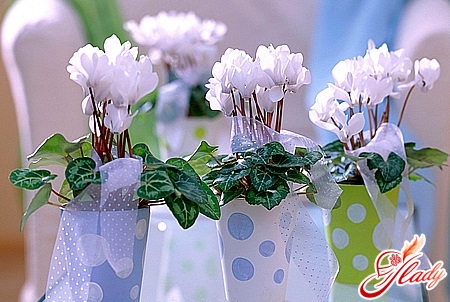
Cyclamen transplantation
In autumn a new flowering period begins, whichis marked by the growth of small leaves. At this time, it is necessary to engage in plant transplantation. The pot must be small for transplantation: for a small one and a half-year-old tuber, a pot of diameters no larger than 8 cm is selected; for bulbs 2-3 years suit 15 cm pot. Another option for the correct selection of the pot is as follows: the distance between the edge of the pot and the tuber itself should be 3 to 4 cm. If a cyclamen is more often rotten in a large pot, then a premature and short bloom is possible in a small pot. The result of the optimally selected pot will be a lush bloom and a healthy root. The old soil is replaced completely. The new soil mixture can be purchased in the garden store in ready form with the mark "for cyclamen". When self-preparing soil use leaf earth, humus, river sand, turf or peat. It is mandatory to have a drain and a vent at the bottom of the pot. The prepared soil mixture is recommended to be calcined or steamed, treated with a weak solution of potassium permanganate, because cyclamens are very easily susceptible to pest attack. It is necessary to transplant the flower neatly, without damaging the basal com. Pay special attention: in order for your cyclamen to bloom, when transplanting the Persian variety, the bulb can not be completely buried in the soil, be sure to leave 1/3 of the tuber on the surface. When transplanting other species, a deep landing is allowed, but when transplanting a "Neapolitan" variety, it is absolutely necessary to immerse the tubers completely in the ground. Once again, we emphasize: improper planting of the bulb is a common mistake, and the main reason why, actually, the cyclamen do not bloom. After the transplant, the cyclamen is placed in a cool bright place and gradually begins to increase watering. At the stage of intensive growth of leaves before flowering, it is necessary to feed the flower with mineral fertilizers. It is best to use organic compounds. Avoid large amounts of nitrogen - this can lead to decay of the root system. 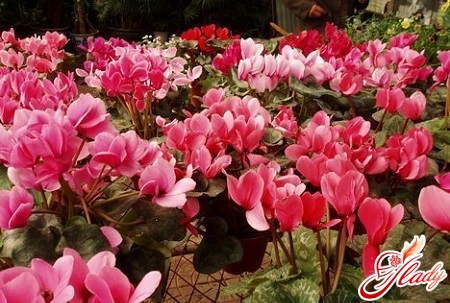
Diseases and pests that inhibit flowering
Often, rapid color loss and delaythe very period of flowering lead to some cyclamen diseases. Let us dwell on the most common types. Fusarium - damage to plant tissues by fungi, releasing toxic substances into the vessels of leaves. It is shown by the yellowing of the leaves from the tops, mainly from one side of the plant. Gradually, the whole flower becomes infected, including the tuber, which sooner or later leads to death. Wet rot is a bacterial and very dangerous disease. The initial stage is accompanied by a sharp fading and the smell of rot from the tuber. The root system is also exposed to infection. There is no method to combat decay, the plant must be destroyed. Gray rot is a fungal disease, manifested by the growth of gray mold on the leaves, which causes the plant to turn yellow and die. Aphids are small, pesky insects of gray, green or black color. Dangerous because it sucks the juice from the leaves of the plant. You can detect by folding the leaves, the buds do not open, but the flowers are covered with sticky discharge. Further plant growth slows down. The situation worsens the defeat of sticky leaves with a black fungus. The fungus in turn worsens the gas exchange. Cyclamenic mite is a very small insect, mostly yellow. At the initial stage, the tick settles on the inside of the leaf. The affected leaves curl, buds wither and fall off. The thrips are the pest of the oval form growing to 2 mm. With the help of wings they fly from a sick plant to a healthy one. After himself leaves a silver trail, affects mainly the leaves, the flowers are covered with spots and gradually fade. Methods of pest control allow the use of chemical and biological products. But the best treatment, as always, is prevention, which consists in regular inspection of the cyclamen, periodic processing of leaves with special solutions and proper maintenance of the plant. On average cyclamen lives 15-20 years, and in one period you can get up to 70 flowers. Gradually fading buds should be removed together with a pedicel. Leave the yellowing leaves on the tuber itself. By the way, cut flowers of cyclamen perfectly stand in the water. Scattered ends and regular water changes in the vase extend the shelf life to 2-3 weeks. You will be interested to learn about one more feature of the cyclamen tubers - they contain a toxic substance that causes inflammation of the skin. Whereas folk medicine uses this flower in the treatment of sinusitis, rheumatism, and homeopaths use cyclamen for the treatment of female genital organs and diseases of the central nervous system. In ancient books, cyclamen is called pork bread, because these animals eagerly feed on the roots of the cyclamen. But we, lovers and connoisseurs of indoor plants, cyclamen is close "fluttering" like butterflies flowers. Observing all the above recommendations, you will give yourself joy and sunshine in the long winter months, admiring the magnificent flowers.




